Section 1 - Introduction, logistics, itinerary and general information.
Section 2 - Birding sites (part 1).
Section 3 - Birding sites (part 2).
Section 4 - Birding sites (part 3).
Section 5 - Annotated checklist.
Reserva Biological de Una
Reserva Biolôgica de Una (5,257 ha.) holds the largest, and only protected, piece of primary lowland swamp-forest in Bahia, and was created in an effort to preserve the highly endangered Bahia Lion Tamarin Leontopithecus chrysomelas (sometimes treated as a subspecies of Gold-and-black Lion Tamarin L. rosalia). Urgent funding is being sought to try to extend the reserve to include the surrounding second growth before all available land disappears. The reserve is located a few kilometres north of the town of Una, 45 kilometres south of Ilhéus in southern Bahia.

|
Although accommodation is available in Una itself, at the Una Hotel, this looked decidedly dodgy. Others recommended staying in either Ilhéus or Canavieiras (54 kilometres to the south of Una). However, we discovered the excellent Pousada Vila do Mar, which cost $17 pp/night ($22 with breakfast included). To find the pousada, drive 13.0 kilometres south from the bridge spanning the river in Una, and turn left, toward the coast, at the large sign advertising the very expensive Hotéis Transamericas. The pousada is a further 2.7 kilometres on the right. Evening meals are available at the large "turista" restaurant a kilometre further past the pousada. The restaurant is well advertised en route, and was recommended by the pousada owner, though we didn't try it, due to a general power failure. Another nearby hotel is the Pousada Real, located at the end of this road. En route, at 13.4 kilometres, the road passes a small, but interesting wet area on the left, where we saw Black-capped Donacobias, and heard Ash-throated Crake. This could well warrant further investigation, especially as the water (at least during our visit) appears rather shallow, and the grass short.
Despite the absence of a bird species list for Una, and not knowing of any other birders whom had previously visited, we decided to visit for several reasons; Firstly, as rare primates exist in the reserve, rare birds might reasonably be expected to do so. Secondly, we liked the idea of visiting an under-watched place. Thirdly, and most importantly, we felt that this would be a good locality to look for the virtually unknown Stresemann's Bristlefront and Bahia Tapaculo. |
Given what little is known of either of these two species, lowland swamp forest in central/southern Bahia (a rare habitat) should be the place in which look. Indeed, although we failed to find them - due principally to the dry season - we felt that a search at the appropriate time of year, when other ground birds are calling, could well be fruitful. Permission to visit the reserve is granted by the reserve director Dr. Saturnino Neto Sousa (see useful contacts above). Those wishing to visit should write or fax Dr. Souza stating their interest and reason for visiting the reserve. To access the reserve, drive north along the main coastal highway (not numbered) from Una toward Ilhéus for 13.4 kilometres, and turn left (west) onto the dirt track next to a bus stop (see map below). Only the first 500 metres of this track is easily driveable with a two-wheel-drive, after which it is better to walk. Keep left at the first fork, and right at the second. A further 200 metres brings you to the reserve gate.
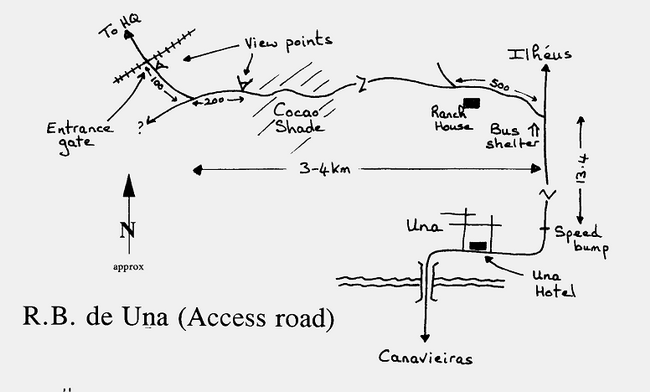
During the first morning of our visit we were accompanied by José, a research assistant, who showed us the various habitat zones of the reserve. For the remainder of our stay we were allowed to wander the reserve using José's map and a compass. Our main surprise was to find that the so-called "primary forest" within the reserve is actually old secondary, while the secondary forest is actually very immature second growth. We worked several of the trails, though some (especially those west of the main track through the reserve) are now overgrown. As our visit coincided with the end of the dry season, song was poor, and we saw only a few species of note. Even in the swamp forest, species were hard to find, though we did hear Black-hooded Berryeater. On our second morning we decided to bird the 3-4 kilometre access road of the reserve starting from the main highway, which passes through cleared, agricultural areas and, more interestingly, areas of cocoa shade forest. This was extremely productive - some of the more notable species being Dubois Seedeater, Blond-crested Woodpecker, and Golden-tailed Parakeet. However, the highlight of the morning was a group of six Bahia Lion Tamarin feeding in cocoa shade forest, found at the only point along the track where the shade forest trees actually meet above the road (thereby allowing the possibility to cross from one zone of forest to the other without descending to the ground). Two viewpoints, one 300 metres from the reserve gate, the another at it, allow a reasonable view across the forest canopy, and are good places from which to scan for White-winged Cotinga. Other than a brief survey (Gonzaga et. al. 1986), Una does not appear to have received much attention ornithologically. One important note made during this survey is the probability that Red-billed Currasow still occurs in the reserve, as it was reported to do so by reserve wardens. During one brief roadside stop, 7.9 kilometres south of Una we found a Buff-breasted Tody-Tyrant, a scarce and little known species of eastern Brazil. This represents a sizeable range extension. This site has been marked on the map above (South of Una), although some luck will be required to relocate it. From the bridge at Una drive south. At 7.8 kilometres a dirt track and house are passed on the left, and at 7.9 kilometres a small bulldozed area (road maintenance?) with a narrow track through some trees can be found. Walk the track as far as the first gate (less than 200 metres) - we found the tody-tyrant and Golden-spangled Piculet in the trees on the right just before the gate.
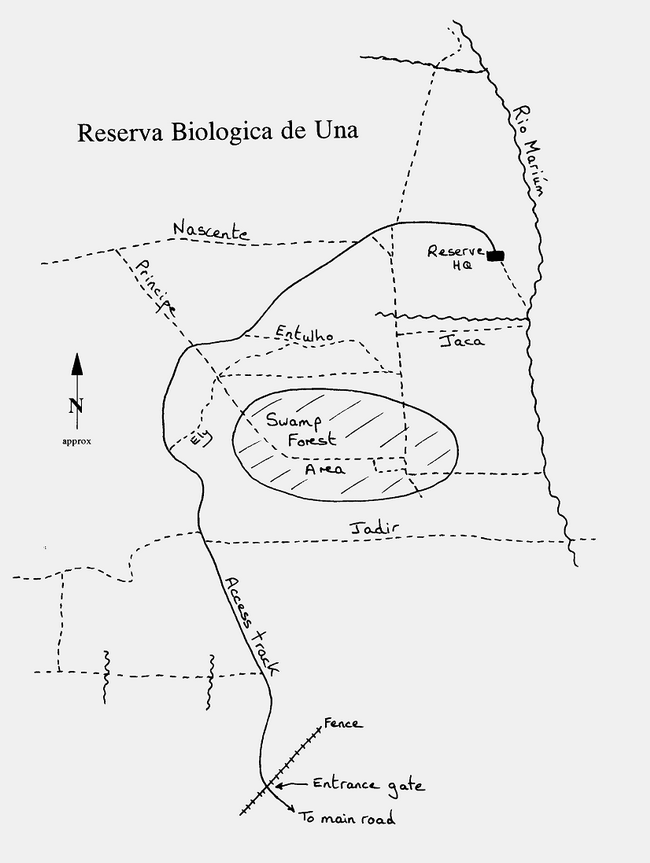
Species recorded from Una:
Solitary Tinamou 1h (r)
Little Tinamou
Variegated Tinamou
Little Blue Heron
Striated Heron
Black Vulture c
Turkey Vulture
Roadside Hawk 1
Grey-lined Hawk
Crested Caracara 2
Yellow-headed Caracara
Laughing Falcon
Aplomado Falcon
Speckled Chachalaca
Rusty-margined Guan
Red-billed Curassow
Southern Lapwing
Spot-winged Wood-Quail
Grey-necked Wood-Rail
Pale-vented Pigeon 3+h
Ruddy Ground-Dove
Blue Ground-Dove
White-tipped Dove 2h
Pileated Parrot
Peach-fronted Parakeet 20+
Cobalt-rumped Parrotlet 4+
Plain Parakeet 6
Golden-tailed Parrotlet 6
Orange-winged Parrot
Smooth-billed Ani 4
Guira Cuckoo
Striped Cuckoo 1h
Burrowing Owl
Tropical Screech-Owl
Least Pygmy-Owl
Chestnut-bellied Nighthawk
Pauraque
Grey-rumped Swift 20+
Lesser Swallow-tailed Swift
Rufous-breasted Hermit
Reddish Hermit 4 (r)
Swallow-tailed Hummingbird 2+
Black Jacobin 3 (r)
Black-throated Mango 1+
Frilled Coquette 2
Glittering-bellied Emerald 2+
Long-tailed Woodnymph 3 (r)
Violet-capped Woodnymph 3 (r)
Rufous-throated Sapphire 3
White-chinned Sapphire 2 (r)
Sombre Hummingbird 2
White-tailed Trogon 2+h (r)
Ringed Kingfisher
Rufous-tailed Jacamar 1
White-fronted Nunbird 3+
Channel-billed Toucan 3+
Golden-spangled Piculet 2
Little Woodpecker 2
Yellow-eared Woodpecker
Yellow-throated Woodpecker 1 (r)
Green-barred Woodpecker
Campo Flicker
Blond-crested Woodpecker 2
Cream-crested Woodpecker
Lineated Woodpecker
Thrush-like Woodcreeper 2 (r)
Olivaceous Woodcreeper 2
Wedge-billed Woodcreeper
Planalto Woodcreeper
Buff-throated Woodcreeper 2+
Lesser Woodcreeper
Sooty-fronted Spinetail 1
Common Thornbird 2
Firewood-gatherer
Black-capped Foliage-gleaner
White-eyed Foliage-gleaner 1 (r)
Atlantic Plain Xenops
Streaked Xenops 4
Great Antshrike 1h
Chestnut-backed Antshrike
Variable Antshrike
Spot-breasted Antvireo 1h
Cinereous Antshrike
Band-tailed Antwren
Pileated Antwren
White-fringed Antwren
Scaled Antbird 1 (r)
White-shouldered Fire-eye
Rufous-capped Antthrush
Variegated Antpitta
Black-cheeked Gnateater
Cinereous Mourner 1 (r)
|
Black-headed Berryeater 1h
Screaming Piha c (r)
White-winged Cotinga 4+ (r)
Red-headed Manakin 10 (r)
White-crowned Manakin 2 (r)
Blue-backed Manakin 4 (r)
White-bearded Manakin
Striped Manakin 3+ (r)
Ochre-bellied Flycatcher 1 (r)
Buff-breasted Tody-Tyrant 1
Common Tody-Flycatcher 1
Southern Beardless Tyrannulet 3
White-lored Tyrannulet
Yellow Tyrannulet 2 (r)
Forest Elaenia
Yellow-bellied Elaenia 2
Lesser Elaenia
Eastern Olivaceous Flatbill 2 (r)
Yellow-breasted Flycatcher
Bran-coloured Flycatcher 1 (r)
Myiobius sp.
Long-tailed Tyrant 1
Masked Water-Tyrant
Bright-rumped Attila 1+
Greyish Mourner
Dusky-capped Flycatcher 1+
Short-crested Flycatcher
Tropical Kingbird c
Variegated Flycatcher
Boat-billed Flycatcher4
Streaked Flycatcher 1
Social Flycatcher 2+
Piratic Flycatcher
Great Kiskadee 10+
Thrush-like Schiffornis 2 (r)
Green-backed Becard 4+
Black-capped Becard 1
Rufous-browed Peppershrike
Red-eyed Vireo 6+
Lemon-chested Greenlet 1h
Rufous-bellied Thrush 4+
Pale-breasted Thrush
Creamy-bellied Thrush
Cocoa Thrush 1+
White-necked Thrush 10+
Black-capped Donacobius 3+
Moustached Wren
Long-billed Wren 1+
Southern House Wren 4+
Long-billed Gnatwren
White-winged Swallow c
White-rumped Swallow 2+
Brown-chested Martin
Grey-breasted Martin 6
Southern Rough-winged Swallow c
Grassland Sparrow 2
Pectoral Sparrow
Bananaquit c
Orange-headed Tanager
Hooded Tanager 2
Flame-crested Tanager
White-lined Tanager 2+
Silver-beaked Tanager
Brazilian Tanager 4+
Sayaca Tanager c
Palm Tanager c
Purple-throated Euphonia 4+
Violaceous Euphonia 10+
Chestnut-bellied Euphonia
Blue-naped Chlorophonia
Turquoise Tanager 6+
Green-headed Tanager 6+
Burnished-buff Tanager 4+
Silvery-breasted Tanager 4+
Blue Dacnis 4+
Green Honeycreeper 10+
Red-legged Honeycreeper 10+
Saffron Finch 2
Blue-black Grassquit
Yellow-bellied Seedeater 4+
Dubois' Seedeater 4+
Double-collared Seedeater
White-bellied Seedeater 2
Lesser Seed Finch
Yellow-green Grosbeak 10+
Buff-throated Saltator
Green-winged Saltator
Yellow-rumped Cacique c
Red-rumped Cacique 20+
Troupial 1
Shiny Cowbird 10 |
Porto Seguro
More correctly known as Reserva Florestal Rio Doce, this reserve offers the chance of finding several of the specialities of lowland forest including Red-browed Parrot, Hook-billed Hermit, Banded Cotinga and White-winged Cotinga. Previously it was necessary to obtain a permit from the office in Porto Seguro, but now it appears to be no problem just walking in. We encountered one of the patrolling wardens, who merely waved and continued on his way. As the town of Porto Seguro, 15 kilometres away, is a major holiday resort, finding accommodation is not a problem, although it proves difficult to find something quiet. We stayed at the Pousada Jandeias which, being off the main road, was reasonably quiet and good value at $27 for a triple room.
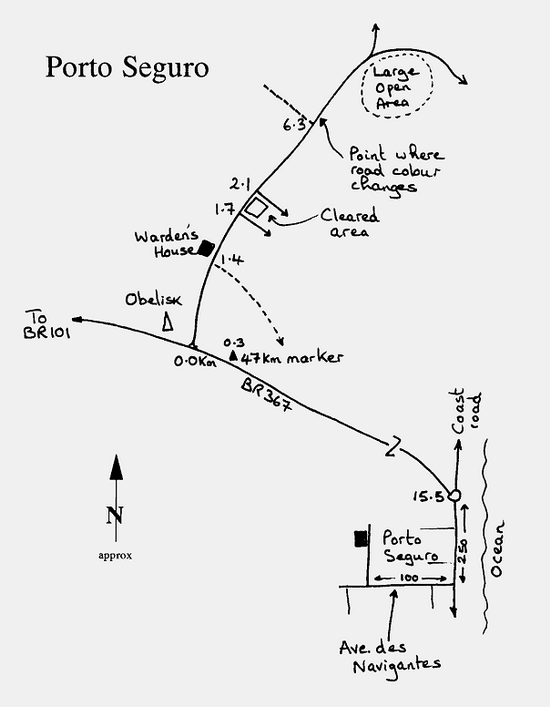
|
Similarly, the town is packed with eating establishments. From the round-about at the entrance of town drive 250 metres along the coast road, and turn right onto Avenida des Navigantes. The next right, after 100 metres, is an unmarked dirt road along which the pousada can be found on the left side. The entrance to the reserve, not signposted from the road, is found 15.5 kilometres from Porto Seguro, adjacent to a large roadside obelisk reading Centro de Educaão Ambiental, 300 metres west of the Km 47 marker. Principle access to the forest is provided by a wide driveable track passing through the centre of the reserve. A few trails discovered are marked on the map. Although our two half-days here were spent walking the main road searching unsuccessfully for Banded Cotinga, several other good species were encountered, including White-winged Cotinga, Red-browed Parrot, Blue-throated Parakeet, and Tawny-browed Owl. |
Species recorded from Porto Seguro:
Solitary Tinamou 1h
Little Tinamou 1+h
Variegated Tinamou
Magnificent Frigatebird
Black Vulture c
Turkey Vulture
Lesser Yellow-headed Vulture
American Swallow-tailed Kite
Double-toothed Kite 1
Grey-headed Kite
Hook-billed Kite
Plumbeous Kite 5
Savanna Hawk
Black Hawk-Eagle
Bicoloured Hawk
Grey-lined Hawk
Roadside Hawk 2
Crested Caracara 4
Yellow-headed Caracara 2
Collared Forest-Falcon
Laughing Falcon
Collared Forest-Falcon
Rusty-margined Guan
Ash-throated Crake
Solitary Sandpiper
Spotted Sandpiper 1
Scaled Pigeon
Plumbeous Pigeon 4+
Scaled Dove
Ruddy Ground-Dove 2
Blue Ground-Dove 4h
White-tipped Dove 1h
Grey-fronted Dove
Ruddy Quail-Dove
Peach-fronted Parakeet
Blue-throated Parakeet 25+
Blue-winged Parrotlet 10+
Plain Parakeet 1
Golden-tailed Parrotlet
Pileated Parrot
Blue-headed Parrot 2+
Red-browed Parrot 6
Mealy Amazon
Squirrel Cuckoo 2
Smooth-billed Ani 8+
Guira Cuckoo
Barn Owl
Variable Screech-Owl 2h
Spectacled Owl
Tawny-browed Owl 2
Least Pygmy-Owl 2h
Ferruginous Pygmy-Owl
Chestnut-bellied Nighthawk 2
Pauraque 4+
White-collared Swift
Grey-rumped Swift 20+
Ashy-tailed Swift
Lesser Swallow-tailed Swift
Reddish Hermit
Hook-billed Hermit
Racquet-tailed Coquette
Plain-bellied Emerald
Black Jacobin
Black-throated Mango
Violet-capped Woodnymph 2
Rufous-throated Sapphire 2+
White-chinned Sapphire
Black-eared Fairy
White-tailed Trogon 2+
Black-throated Trogon 2h
Rufous-capped Motmot
Rufous-tailed Jacamar
Crescent-chested Puffbird
White-necked Puffbird
White-fronted Nunbird
Swallow-wing 10+
Black-necked Aracari 5+
Channel-billed Toucan 3
White-barred Piculet
Yellow-fronted Woodpecker 3
Little Woodpecker 2
Red-stained Woodpecker
Yellow-eared Woodpecker
Yellow-throated Woodpecker
Ringed Woodpecker
Lineated Woodpecker 1
Robust Woodpecker
Thrush-like Woodcreeper
Wedge-billed Woodcreeper
Planalto Woodcreeper
Buff-throated Woodcreeper 1h
Scaled Woodcreeper
Lesser Woodcreeper
Black-billed Scythebill 1
Black-capped Foliage-gleaner
White-eyed Foliage-gleaner 4+h
Plain Xenops
Streaked Xenops
Barred Antshrike
Chestnut-backed Antshrike
Eastern Slaty Antshrike 3+h
|
Cinereous Antshrike
Band-tailed Antwren
Black-capped Antwren
Rufous-winged Antwren
White-fringed Antwren
Ochre-rumped Antbird 1h
Scaled Antbird
White-shouldered Fire-eye
Rufous-capped Antthrush
Variegated Antpitta
Black-cheeked Gnateater
Cinereous Mourner
Black-headed Berryeater
Screaming Piha c
Banded Cotinga
White-winged Cotinga 10
Bare-throated Bellbird
Red-headed Manakin 1
Swallow-tailed Manakin
White-crowned Manakin 1
White-bearded Manakin 3
Striped Manakin
Sepia-capped Flycatcher
Common Tody-Flycatcher 1
White-lored Tyrannulet
Rough-legged Tyrannulet
Yellow Tyrannulet
Forest Elaenia
Yellow-bellied Elaenia
Tawny-crowned Pygmy-Tyrant
Olivaceous Flatbill
Yellow-olive Flycatcher
Grey-crowned Flycatcher
Yellow-breasted Flycatcher
Bran-coloured Flycatcher
Myiobius sp.
Tropical Pewee
White-headed Marsh-Tyrant
Cattle Tyrant
Grey-hooded Attila
Bright-rumped Attila
Greyish Mourner 3+h
Dusky-capped Flycatcher 1
Short-crested Flycatcher
Brown-crested Flycatcher
Tropical Kingbird c
Boat-billed Flycatcher 10+
Social Flycatcher
Great Kiskadee 8+
Thrush-like Schiffornis
White-winged Becard
Black-capped Becard
Green-backed Becard
Black-tailed Tityra
Black-crowned Tityra 4
Rufous-browed Peppershrike
Red-eyed Vireo 3
Rufous-bellied Thrush
Pale-breasted Thrush
Cocoa Thrush 2
Moustached Wren 2
Southern House Wren
Long-billed Gnatwren
Brown-chested Martin
Grey-breasted Martin 4
Blue-and-white Swallow
Southern Rough-winged Swallow c
Yellow-faced Siskin
Tropical Parula
Grassland Sparrow
Pectoral Sparrow
Bananaquit c
Yellow-backed Tanager
Flame-crested Tanager 1
White-lined Tanager 2
Red-crowned Ant Tanager
Brazilian Tanager
Sayaca Tanager 2
Palm Tanager c
Violaceous Euphonia 4
Orange-bellied Euphonia
Chestnut-bellied Euphonia
Turquoise Tanager 4
Silvery-breasted Tanager
Green-headed Tanager
Burnished-buff Tanager 2
Blue Dacnis
Green Honeycreeper 2
Red-legged Honeycreeper 4
Swallow-Tanager
Wedge-tailed Grass-Finch
Blue-black Grassquit
Dubois' Seedeater
Double-collared Seedeater
White-bellied Seedeater
Lesser Seed Finch
Yellow-green Grosbeak 2
Buff-throated Saltator
Red-rumped Cacique 20
Yellow-rumped Cacique
Shiny Cowbird |
Monte Pascoal National Park
Monte Pascoal contains, what is now, the largest tract of forest remaining in Bahia. Although officially protected, hunting still continues, and recently the government has allocated over 40% of the land as an Indian reservation. This will undoubtedly result in further clearance, hunting and a general degradation of the prime habitat. A number of Indians sell tourist trinkets outside the main entrance, the majority of which feature hard woods and parrot feathers.
Monte Pascoal (Easter Mountain) is the 536 metre volcanic plug thrusting-up above the surrounding canopy; so-named by Portuguese explorers whose first sight of land in the New World, was this mountain on Easter Sunday.
It is an hour's hard climb to the summit, but the spectacular view from the top is worthwhile, and additionally offers the opportunity of scanning the large area of rain forest below for perched and soaring raptors. The raptor list is impressive with good possibilities of Harpy Eagle, Black-and-White Hawk-Eagle, Mantled Hawk, and White-naped Hawk. King Vulture is fairly common.
The park is open daily from 08h00 to 17h00, but fortunately gaining access early and late is not a problem as the entrance gate is not locked. Entrance is free, but you are asked to sign the visitors book on arrival. It is a great pity that accommodation is not available at the visitor centre. Unstaffed, and apparently largely unused, the provision of a few basic facilities would render it a major attraction and overnight stop to anyone interested in natural history. A nicest feature of Monte Pascoal is the lookout from the visitor centre, from which it is possible to scan the canopy at eye-level - even from the comfort of a chair - from the visitor centre. This is a very easy and relaxing way to pass a day, and probably the most reliable way in which to find both Banded Cotinga and White-winged Cotinga, as well as Bare-throated Bellbird and several raptor species. This is one of the few places we visited where a scope is highly desirable. One of the most important birds to look for at Monte Pascoal is the Black-headed Berryeater, a declining endemic of north-eastern Brazil. Most visitors find it around the visitor centre, though we failed - probably due to the time of year, as few species were singing.
Officially, without the accompaniment of a park guard, visitors are confined to viewing the visitor centre and walking the summit track. Those wishing to explore the interior of the park should arrange for permission and a guide through IBAMA. Although it would be highly interesting to explore to park further, most birders are content to work the public areas, as well as the track leading to the old ranger station. These areas hold many species of interest. The one exception could be Red-billed Currasow, which probably still exists in the interior of the park, but like over most of its dwindling range, would be extremely difficult to find.
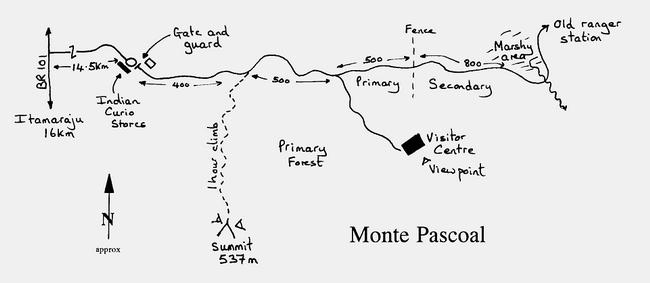
Chief target species at Monte Pascoal, many of which can also be found at Porto Seguro, include White-naped Hawk, Band-tailed Antwren, Hooded Berryeater, White-winged Cotinga, and Salvadori's Antwren (scarce). As no accommodation is available at the park, the most convenient place to stay is Itamaraju, about 30 kilometres away on good roads. Several hotels are available, though the only one of reasonable quality appears to be the Monte Pascoal Hotel, which at $75 for a triple was expensive, but good. The hotel is readily found on entering Itamaraju from the north due to its massively lit-up red and green sign. Address: Monte Pascoal Hotel, BR-101 Norte, Km 808, Itamaraju. Tel/Fax: (073) 294-1194.
Species recorded from Monte Pascoal:
Solitary Tinamou
Little Tinamou 2h
Variegated Tinamou 5
Tataupa Tinamou
Capped Heron
Black Vulture c
Turkey Vulture 4
Lesser Yellow-headed Vulture 1
King Vulture 5
American Swallow-tailed Kite
Double-toothed Kite 1
Plumbeous Kite
Grey-bellied Hawk 2
White-necked Hawk 2
White-tailed Hawk
Mantled Hawk 1
Harris' Hawk
Roadside Hawk 1+
Savanna Hawk
Harpy Eagle
Black Hawk-Eagle
Black-and-white Hawk-Eagle 1
Crested Caracara
Yellow-headed Caracara
Laughing Falcon
Barred Forest-Falcon
Collared Forest-Falcon
American Kestrel
Bat Falcon
Speckled Chachalaca
Rusty-margined Guan
Black-fronted Piping-Guan
Red-billed Curassow
Spot-winged Wood-Quail
Russet-crowned Crake
Rufous-sided Crake
Clapper Rail
Uniform Crake
Blackish Rail
Solitary Sandpiper
Southern Lapwing
Scaled Pigeon 2
Picazuro Pigeon
Plumbeous Pigeon
Pale-vented Pigeon
Ruddy Ground-Dove
White-tipped Dove
Grey-fronted Dove
Ruddy Quail-Dove
White-eyed Parakeet
Peach-fronted Parakeet
Blue-throated Parakeet 10
White-eared Parakeet
Blue-winged Parrotlet 4
Plain Parakeet 2
Golden-tailed Parrotlet
Golden-capped Parakeet
Blue-headed Parrot 2
Red-browed Parrot
Mealy Amazon
Squirrel Cuckoo
Smooth-billed Ani
Guira Cuckoo
Striped Cuckoo
Variable Screech-Owl
Ferruginous Pygmy-Owl
Chestnut-bellied Nighthawk
Pauraque
Ocellated Poorwill
Scissor-tailed Nightjar
Sooty Swift
White-collared Swift
Grey-rumped Swift 20+
Ashy-tailed Swift
Lesser Swallow-tailed Swift
Rufous-breasted Hermit
Planalto Hermit
Reddish Hermit
Hook-billed Hermit
Swallow-tailed Hummingbird
Black Jacobin
Black-throated Mango
Racquet-tailed Coquette
Long-tailed Woodnymph
Violet-capped Woodnymph
White-chinned Sapphire
Versicoloured Emerald
Black-eared Fairy
White-tailed Trogon
Ringed Kingfisher
Green Kingfisher
Rufous-capped Motmot
Rufous-tailed Jacamar
White-fronted Nunbird
Buff-bellied Puffbird
Swallow-wing
Black-necked Aracari 3
Spot-billed Toucanet
Channel-billed Toucan 4
White-barred Piculet
Yellow-fronted Woodpecker
Little Woodpecker 4
Yellow-eared Woodpecker
Yellow-throated Woodpecker 2
Blond-crested Woodpecker 1
Ringed Woodpecker
Lineated Woodpecker
Robust Woodpecker
Plain-brown Woodcreeper
Thrush-like Woodcreeper 2
Olivaceous Woodcreeper
Wedge-billed Woodcreeper
Planalto Woodcreeper
Buff-throated Woodcreeper 4+h
Lesser Woodcreeper 4+
Red-billed Scythebill
Chicli Spinetail
Grey-bellied Spinetail
White-eyed Foliage-gleaner
Tawny-throated Leaftosser
|
Plain Xenops 1
Streaked Xenops 1
Chestnut-backed Antshrike
Eastern Slaty Antshrike 2h
Cinereous Antshrike
White-flanked Antwren 1
Salvadori's Antwren 1
Band-tailed Antwren 3
Rufous-winged Antwren 1
Scaled Antbird
White-shouldered Fire-eye 3h
Rufous-capped Antthrush
Black-cheeked Gnateater
Cinereous Mourner
Black-headed Berryeater
Screaming Piha c
Banded Cotinga 1
White-winged Cotinga
Bare-throated Bellbird 1+5h
Red-headed Manakin
White-crowned Manakin 1
White-bearded Manakin 1
Striped Manakin
Grey-hooded Flycatcher
Ochre-bellied Flycatcher
Sepia-capped Flycatcher 2
Common Tody-Flycatcher
Yellow Tyrannulet 2
Forest Elaenia
Yellow-bellied Elaenia 2
Bay-ringed Tyrannulet
Swallow Flycatcher 5
Eared Pygmy-Tyrant
Olivaceous Flatbill
Yellow-olive Flycatcher
Grey-crowned Flycatcher
Yellow-breasted Flycatcher
Three-striped Flycatcher
Bran-coloured Flycatcher
Black-tailed Flycatcher
Masked Water-Tyrant
Grey-hooded Attila
Bright-rumped Attila
Greyish Mourner 1h
Cinereous Mourner
Dusky-capped Flycatcher 2+
Tropical Kingbird c
Boat-billed Flycatcher 4
Streaked Flycatcher
Social Flycatcher 4
Piratic Flycatcher
Great Kiskadee 2+
Thrush-like Schiffornis
Chestnut-crowned Becard
White-winged Becard
Black-capped Becard
Cinereous Becard
Black-tailed Tityra
Black-crowned Tityra 2
Rufous-browed Peppershrike
Red-eyed Vireo
Rufous-brown Solitaire
Yellow-legged Thrush
Eastern Slaty Thrush
Rufous-bellied Thrush
Pale-breasted Thrush 2
Creamy-bellied Thrush
Cocoa Thrush 4+
Black-capped Donacobius
Thrush-like Wren
Moustached Wren 6
Long-billed Wren
Southern House Wren
Long-billed Gnatwren
Grey-breasted Martin 6
Blue-and-white Swallow 10+
Southern Rough-winged Swallow 4
House Sparrow
Tropical Parula
Masked Yellowthroat
Basileuterus sp.
Flavescent Warbler
Grassland Sparrow
Bananaquit 8
Cinnamon Tanager 2
Yellow-backed Tanager
Olive-green Tanager
Flame-crested Tanager 1
Red-crowned Ant Tanager
Brazilian Tanager
Hepatic Tanager
Sayaca Tanager
Golden-chevroned Tanager
Palm Tanager c
Purple-throated Euphonia
Violaceous Euphonia 4
Orange-bellied Euphonia
Chestnut-bellied Euphonia 2
Turquoise Tanager 2+
Silvery-breasted Tanager
Green-headed Tanager 14+
Burnished-buff Tanager
Blue Dacnis 6+
Green Honeycreeper 4
Red-legged Honeycreeper
Blue-black Grassquit
Yellow-bellied Seedeater
Dubois' Seedeater 3+
Double-collared Seedeater 2+
Lesser Seed Finch
Yellow-green Grosbeak 4
Buff-throated Saltator 10+
Crested Oropendola
Red-rumped Cacique 10
Troupial
White-browed Blackbird
Chopi Blackbird
Shiny Cowbird
Giant Cowbird |
Jeremoabo
On either travelling to or from Canudos, one should drive the BR235 via Jeremoabo, as this offers the possibility to look for Pectoral Antwren. This rare and elusive species has a very patchy distribution, and appears to be missing from large areas of seemingly suitable habitat. One regular spot appears to be an area of unusually tall and humid gallery forest within the caatinga about 24 kilometres west of Jeremoabo (or 70 kilometres east of Canudos if travelling from the west). Turn off the main BR110 Salvador to Paulo Alfonso road, onto the BR235 just south of Jeremoabo. Shortly after the road crosses a bridge where you should zero the trip meter. At 0.2 kilometres take the right fork which, although not signposted, is the BR235 to Canudos. On approach to the area the tall gallery forest will be very evident.
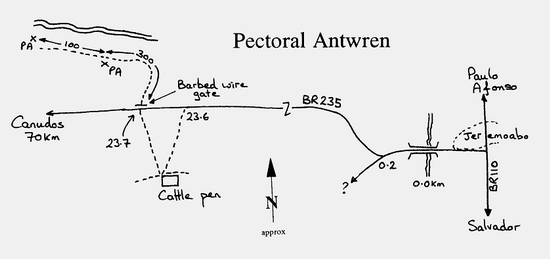
|
We tried several tracks in the area before eventually finding three singing male Pectoral Antwren along the track on the north side of the road, 23.7 kilometres from the bridge. This track was marked by a barbed-wire gate, with another wide track on the south side of the road leading to a cattle pen. As the forest here is fairly humid the whole area was quite rich in birdlife. Ash-throated Casiornis has been recorded. |
Valença
This area of shade-forest edge and secondary growth was visited on a recommendation. Although we only spent one morning here, the area certainly warrants further investigation, as away from the main access track a large amount of coffee shade-forest can be seen. The area appears to be managed by some sort of farming cooperative, and on one occasion we were asked what we were up to, but were allowed to continue after mumbling something about studying birds. This appears to be a good site for Golden-tailed Parakeet and Pheasant Cuckoo.
Accommodation can be found in Valença, where we stayed at the plush Rio Una Hotel ($75 for a triple) located across the river from town. Address: Rio Una Hotel, Rua Maestro Barrinha, Graça. Tel: 741-1614. Fax: 741-2387. Cross the river, turn right, go past the roots of the last old tree in Valença, then turn left. Proceed to a signpost to the hotel, and turn right. The hotel is about one block down on the right.
To gain access to the birding area, drive south from Valença along the coast road (not numbered) toward Itubera for 26 kilometres, and turn right (west) on a wide dirt track. The coast road is well marked with kilometre markers, and the track would be exactly at the Km 66 marker, except that it appears to have been removed. This track is wet and muddy, and was only driveable for a few hundred metres in our two-wheel-drive. Park and walk the main track, which appears to go for several kilometres.
Species recorded from Valença:
Small-billed Tinamou
Black Vulture c
Turkey Vulture 20
Lesser Yellow-headed Vulture
White-tailed Kite 1
Roadside Hawk 1+
Zone-tailed Hawk
Crested Caracara 4
Yellow-headed Caracara
Pale-vented Pigeon
Ruddy Ground-Dove
White-tipped Dove 3+h
Peach-fronted Parakeet 10
Blue-winged Parrotlet 4+
Plain Parakeet 12
Golden-tailed Parrotlet 6
Squirrel Cuckoo 2
Smooth-billed Ani
Striped Cuckoo
Pheasant Cuckoo 3+
Barn Owl
Chestnut-bellied Nighthawk
Lesser Swallow-tailed Swift
Rufous-breasted Hermit
Reddish Hermit
Swallow-tailed Hummingbird
Black Jacobin 1+
Black-throated Mango 2
Blue-chinned Sapphire 2+
Glittering-bellied Emerald 3+
White-chinned Sapphire
Black-eared Fairy
Rufous-tailed Jacamar
Black-necked Aracari
Channel-billed Toucan 1
Golden-spangled Piculet 2
Green-barred Woodpecker 1
Thrush-like Woodcreeper
Buff-throated Woodcreeper 1+
Lesser Woodcreeper
Sooty-fronted Spinetail 4
Chicli Spinetail
Yellow-chinned Spinetail
Striated Softtail
Common Thornbird
White-eyed Foliage-gleaner 1h
Plain Xenops
Eastern Slaty Antshrike 1+h
Cinereous Antshrike
Band-tailed Antwren
Black-capped Antwren 1h
Scaled Antbird 1h
Streak-capped Antwren
White-shouldered Fire-eye
Rufous-capped Antthrush 1+h
Bare-throated Bellbird 2h
Red-headed Manakin
Blue-backed Manakin
White-bearded Manakin 1
Wied's Tyrant-Manakin
|
Ochre-bellied Flycatcher
Sepia-capped Flycatcher 1
Common Tody-Flycatcher
Yellow Tyrannulet 3+
Yellow-bellied Elaenia
Yellow-breasted Flycatcher
Euler's Flycatcher
Masked Water-Tyrant
White-headed Marsh-Tyrant
Cattle Tyrant 1
Greyish Mourner 1h
Tropical Kingbird c
Boat-billed Flycatcher 2
Social Flycatcher
Great Kiskadee 4
Thrush-like Schiffornis
Black-capped Becard
Rufous-browed Peppershrike
Red-eyed Vireo 2
Rufous-bellied Thrush 4
Pale-breasted Thrush 4
Cocoa Thrush 2
Chalk-browed Mockingbird
Black-capped Donacobius
Moustached Wren 4h
Southern House Wren 2
Long-billed Gnatwren 1+
Tropical Gnatcatcher
White-winged Swallow
Blue-and-white Swallow
Southern Rough-winged Swallow c
House Sparrow
Flavescent Warbler 1
Pectoral Sparrow
Bananaquit c
Chestnut-vented Conebill
Yellow-backed Tanager 4+
Hooded Tanager
Flame-crested Tanager
White-lined Tanager 10
Brazilian Tanager c
Sayaca Tanager 4
Palm Tanager c
Purple-throated Euphonia
Violaceous Euphonia
Turquoise Tanager
Silvery-breasted Tanager
Burnished-buff Tanager 4
Blue Dacnis 2
Green Honeycreeper
Saffron Finch
Yellow-bellied Seedeater c
White-bellied Seedeater 2
Buff-throated Saltator c
Yellow-rumped Cacique
Red-rumped Cacique 10
Epaulet Oriole
White-browed Blackbird
Chopi Blackbird |
Section 1 - Introduction, logistics, itinerary and general information.
Section 2 - Birding sites (part 1).
Section 3 - Birding sites (part 2).
Section 5 - Annotated checklist.






